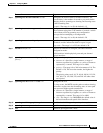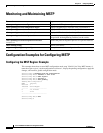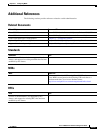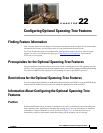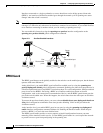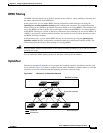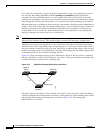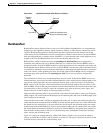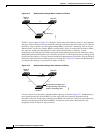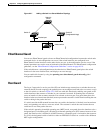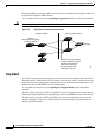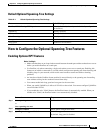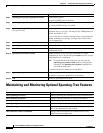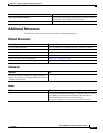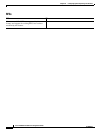
22-5
Cisco IE 2000 Switch Software Configuration Guide
OL-25866-01
Chapter 22 Configuring Optional Spanning-Tree Features
Information About Configuring the Optional Spanning-Tree Features
Figure 22-4 UplinkFast Example After Direct Link Failure
BackboneFast
BackboneFast detects indirect failures in the core of the backbone. BackboneFast is a complementary
technology to the UplinkFast feature, which responds to failures on links directly connected to access
switches. BackboneFast optimizes the maximum-age timer, which controls the amount of time the
switch stores protocol information received on an interface. When a switch receives an inferior BPDU
from the designated port of another switch, the BPDU is a signal that the other switch might have lost
its path to the root, and BackboneFast tries to find an alternate path to the root.
BackboneFast, which is enabled by using the spanning-tree backbonefast global configuration
command, starts when a root port or blocked interface on a switch receives inferior BPDUs from its
designated switch. An inferior BPDU identifies a switch that declares itself as both the root bridge and
the designated switch. When a switch receives an inferior BPDU, it means that a link to which the switch
is not directly connected (an indirect link) has failed (that is, the designated switch has lost its connection
to the root switch). Under spanning-tree rules, the switch ignores inferior BPDUs for the configured
maximum aging time specified by the spanning-tree vlan vlan-id max-age global configuration
command.
The switch tries to find if it has an alternate path to the root switch. If the inferior BPDU arrives on a
blocked interface, the root port and other blocked interfaces on the switch become alternate paths to the
root switch. (Self-looped ports are not considered alternate paths to the root switch.) If the inferior
BPDU arrives on the root port, all blocked interfaces become alternate paths to the root switch. If the
inferior BPDU arrives on the root port and there are no blocked interfaces, the switch assumes that it has
lost connectivity to the root switch, causes the maximum aging time on the root port to expire, and
becomes the root switch according to normal spanning-tree rules.
If the switch has alternate paths to the root switch, it uses these alternate paths to send a root link query
(RLQ) request. The switch sends the RLQ request on all alternate paths and waits for an RLQ reply from
other switches in the network.
If the switch discovers that it still has an alternate path to the root, it expires the maximum aging time
on the interface that received the inferior BPDU. If all the alternate paths to the root switch indicate that
the switch has lost connectivity to the root switch, the switch expires the maximum aging time on the
interface that received the RLQ reply. If one or more alternate paths can still connect to the root switch,
the switch makes all interfaces on which it received an inferior BPDU its designated ports and moves
them from the blocking state (if they were in the blocking state), through the listening and learning
states, and into the forwarding state.
Figure 22-5 shows an example topology with no link failures. Switch A, the root switch, connects
directly to Switch B over link L1 and to Switch C over link L2. The Layer 2 interface on Switch C that
connects directly to Switch B is in the blocking state.
L1
L2 L3
Switch C
Switch A
(Root)
Switch B
UplinkFast transitions port
directly to forwarding state.
Link failure
43576



